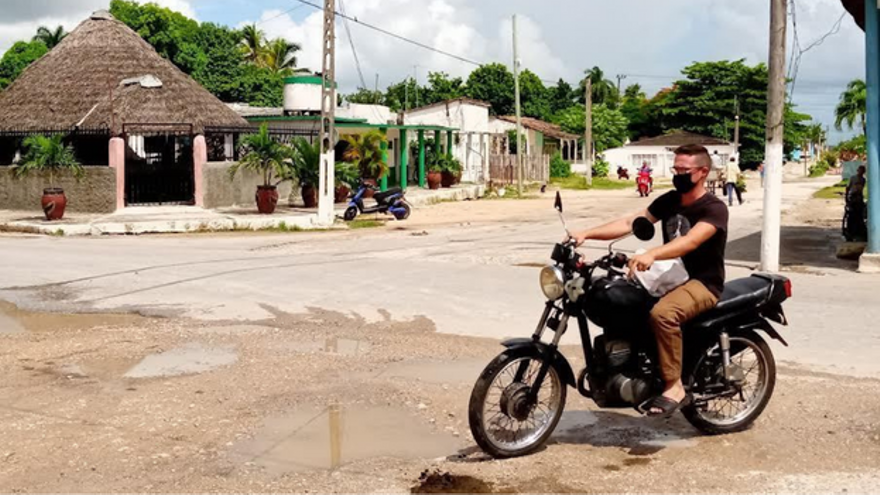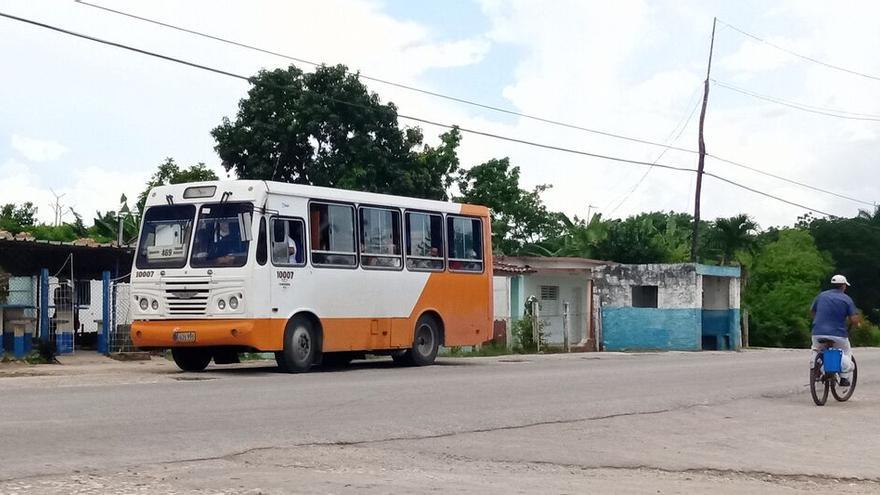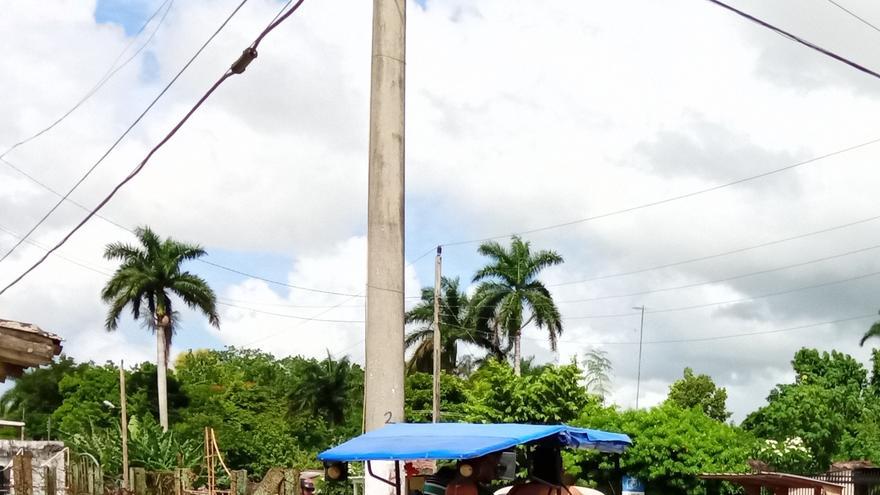
![]() 14ymedio, Yankiel Gutiérrez Faife, Taguayabón (Villa Clara), 23 August 2022 — A blackout in the city is not the same as one in a rural area. When the power goes out in an urban center, even in smaller towns, the buzz of voices begins to break the silence, the heat gets people to talk, scream, bring their furniture onto the porch, and it is possible to smoke and listen to a portable radio.
14ymedio, Yankiel Gutiérrez Faife, Taguayabón (Villa Clara), 23 August 2022 — A blackout in the city is not the same as one in a rural area. When the power goes out in an urban center, even in smaller towns, the buzz of voices begins to break the silence, the heat gets people to talk, scream, bring their furniture onto the porch, and it is possible to smoke and listen to a portable radio.
In contrast, in a settlement, on the side of the road, or by an old sugar mill, blackouts are all-consuming and inhospitable. It’s the ideal opportunity for local thieves, nocturnal marauders, and bandits who always know the area’s uneven geography very well.
Amid the energy crisis some places in Cuba are apparently spared the outages scheduled by Unión Eléctrica. The settlements of Taguayabón and Rosalía, between Camajuaní and Remedios in Villa Clara, seem to be among those “untouchable” points on the map of Cuban blackouts.
The residents, accustomed to an Island where nothing is logical, know that at any moment they will lose the “privilege” of electricity. Suddenly, they explain the miracle alleging that both settlements are close to an area the government considers essential to the functioning of the province, however precarious.
In an “exceptional” stroke of circuit luck, both settlements are near General Docente 26 de Diciembre Hospital, at the entrance to Remedio, and the meat packing plant known as Osvaldo Herrera in the people’s council of Vega de Palma on the route to Vueltas.

The population of each of these areas is small, and thus they do not use excessive amounts of electricity; Taguayabón has 3,308 residents, Rosalía 235 and Vega de Palma 238. Vueltas, Camajuaní, and Remedios, which have tens of thousands of residents, can’t be spared the blackouts.
“We are well,” a resident of Taguayabón told 14ymedio, “but that does not mean we don’t know anything about the blackouts and the protests in other areas. In Camajuaní and Remedios they shut the power off six or twelve hours in a row, but those towns around here haven’t had a blackout in a month. Some joke that this is the new Marianao [a desirable neighborhood in Havana] and they want to move here.”
One ride on the hellish “Slaughterhouse bus,” which takes workers from Salamina near Santa Clara to Vueltas, is enough to make you understand the importance of the meat packing plant in Vega de Palma. The rickety vehicle, loaded with university students, sleep-deprived travelers, and employees of Cárnicos Villa Clara, runs slowly down the road to Camajuaní and takes a detour toward Salamina.
That slaughterhouse, along with two others — Lorenzo González in Sagua and Chichi Padrón in Santa Clara — is responsible for providing the raw materials to the Vega de Palma packing plant. The bus follows the same route as the meat: as soon as it passes Camajuaní it takes the bumpy road to Vueltas, passing el Entronque, another poor settlement.
The Osvaldo Herrera packing plant is run by the Ministry of Food Industry. It employs 250 workers and produces croquettes, canned goods, and sausages, including the unpleasant Cuban version of mortadella, the consumption of which is rationed by the government. Some of the products, those of higher quality, are sent to hotels in the nearby area of Cayería Norte. Another, non-negligible percentage of the sausage “tubes” ends up on the informal market or available through online food stores, which require prepayment in dollars from abroad.
The products at Vega de Palma also require flour from Cienfuegos, and soy from Santiago de Cuba necessary to make mincemeat, another gastronomic headache for Cubans, while other companies provide nylon, cardboard, and preservatives to package the products.
In Vega de Palma there are two sausage-making machines, one meat grinder and one for boneless meat, five steamers with a capacity of 1,500 kilograms, fans, showers for cleaning the meat, and cold storage.
Yolanda, an employee at the packing plant, tells 14ymedio that for a long time her company has not had a backup generator for emergencies. “It depends entirely on the national electric system,” she states, “and although no one confirms that is the reason we don’t have blackouts, we know. Everything would spoil!”

If a blackout would break the cycle, the hotels wouldn’t have sausage, the butchers would not receive the monthly mortadella ration and the government would add another crisis to its long list of unresolved problems.
Nonetheless, not even uninterrupted power guarantees the packing plant’s function. Ernesto, another one of the employees, states that the company does not work every day.
“Sometimes the work is interrupted because there is no gas for the trucks that bring the meat from Salamina. Other times, what is missing is the raw material. We run out of wheat flour and it is impossible to make croquetas. Then we have to make mincemeat or mortadella, while we have the pork or chicken,” he concluded.
The other “guardian angel” against blackouts for these rural settlements is the hospital in Remedios. With 480 workers, of which 67 are doctors and 138 nurses, patients in serious condition are sent here from nearby municipalities including Camajuaní, which only has one polyclinic serving outpatients.
In the old yet very effective hospital, there are pediatric, obstetric, gynecology, anesthesiology, general surgery, intensive care, clinical laboratories, and other wards. A prolonged power outage would be fatal during surgery or for patients on life support.
Of course, neither the colossal packing plant nor the hospital in Remedios provides long-term guarantees. The residents suppose the government has weighed its options: it maintains the power supply because it would be more expensive to fuel generators for both centers.
No one holds out too much hope that the situation will remain as is, of course. If small towns in the Villa Clara countryside have not been affected much by blackouts, it is precisely because they are small. The Cuban government and its energy bureaucracy know where to shut off power and for how long. It is the reason for popular discontent, less controllable as time goes on, and its direct consequence — the nighttime protest.
Translated by: Silvia Suárez
____________
COLLABORATE WITH OUR WORK: The 14ymedio team is committed to practicing serious journalism that reflects Cuba’s reality in all its depth. Thank you for joining us on this long journey. We invite you to continue supporting us by becoming a member of 14ymedio now. Together we can continue transforming journalism in Cuba.
